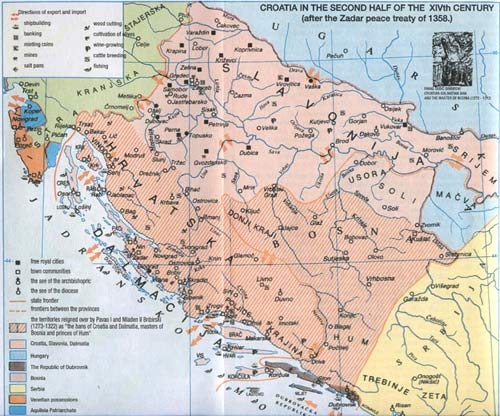Web catalog
Most read
Most read last 7 days
Most Discussed
Top rated
Statistics
- Total registered users: 9860
- Total articles: 23656
- Total comments: 2087
- Last entry: Kebo presenting evidence that Izetbegovic brought mujahideen to Bosnia
- Last update: 11.01.2019. 23:44
Mature Medieval Period: Integration, Expansion and Dissolution (1180 - 1463)

1189.
Kulin made a contract with Dubrovnik in accordance with which merchants from Dubrovnik obtained complete freedom of trading within Bosnia and great influence over the Bosnian economy.
1199. and 1200.
The first news about the heretics in Bosnia reached Rome. The expelled "patareni" (heretics) asked for protection from Kulin.
1203.
The Pope sent deputies to Bosnia to investigate the religious situation there, whereupon the "krstjani" took a vow of obedience to the Holy See. Ban Kulin was mentioned for the last time that year, leaving behind him a son of unknown name (it is possible he was called Stjepan).
1291.
The Franciscans came to Bosnia.
1299.
Croatian banus Pavao Šubic Bribirski takes the title "The Lord of the entire Bosnia" (totius Bosniae dominus). His power won recognition from Gvozd to the Adriatic sea, Neretva and Drina rivers. Bosnia is ruled by his successor Mladen II. Due to the fear of a powerful Croatian state, Mladen is overthrown 1322. by joint action of Croatian peers, Venetians and Croatian-Hungarian king Karlo I. Robert.
1322.-1353.
As the subject of Croatian-Hungarian ruler, banus Stjepan Kotromanic rules over Bosnia. He has extended his power over Soli, Usora, Donji Krajevi ("lower lands") (around Gornja Sana and Vrbas), Završje or Zapadne Strane ("west sides") (Duvno, Livno and Glamoc), Krajina (between Cetina and Neretva rivers) and Zahumlje.
1359.
The Serbian king Dusan went to war with Stjepan II Kotromanic over Hum and penetrated deep into Bosnia. Only the sudden invasion of the Byzantines to the far south saved Stjepan from Dusan, who fled Bosnia.
1377.
Bosnian banus Stjepan Tvrtko Kotromanic, gathering under his rule not only "small land" Bosnia but also Usora, Hum\\\\\\\'s area, Travunja, Primorje, Donji Krajevi, Zapadne Strane and Podrinje, has declared himself as the king of "Srblji, Bosnia and Primorje", by which act Bosnia became an independent kingdom and seceded from Croatian-Hungarian state. By making use of political turmoil in the Croatian-Hungarian state--the twenty-five-years\\\\\\\'s Croatian movement--- king Tvrtko has for a short period around 1390. taken the rule over whole Croatia south from Velebit, except Zadar and Dubrovnik. This traditionally Croatian state survived until 1463., when the Turks have conquered Bosnian kingdom. Elizabeth, the daughter of Bosnian banus Tvrtko Kotromanic and the wife of Croatian-Hungarian king Ludovik Angevin, has ordered to make the silver sarcophagus of St. Simun, a masterwork of Middle-Age Croatian gothic goldsmithery.
1388.
The Bosnian duke Vlatko Vukovic of the tribe Kosaci defeated the Turks at Bilece
1389.
The same duke, together with the Croats (ban Ivan Palizna) and with Bosnian troops fought at Kosovo against the Turks.
1403.-1405.
"Krstjanin" Hrvoje was attracted to the Slavonic liturgy and glagolitics, and he ordered a beautiful glagolitic missal ornameneted with more than 300 initials and 94 colored miniatures from the Catholic writer Butko (it is kept in Constantinople). The "krstjan" writer Hval devoted the Holy Gospel of the New Testament and the Psalter to "the duke of Split, duke of Donji Krajevi and many lands".
1404.
Viganj Miloševic deceased. A part of the grave-stone from his grave in Kocerin field nearby Siroki Brijeg is conserved, with the inscription on it written in Bosnian/Croatoan/Western Cyrillic (this alphabet being known as "bosancica"), which states: "+ Va ime oca i sina i svet(a)go d(u)ha. Amin! Se (ovdje) lezo Vig(a)ri Miloševic. Sluzi banu Stipanu, i kralu T(vrt\\\\\\\')ku, i kralu Dabisi i kralici Grubi, i krala Ostoju. I u to vrime doide, i svadi se Ostoja kral\\\\\\\' s Hercegom i z Bosn(o)m i na Ugre poe Ostoja. To vrime mene Vigna doide koncina i legoh na svom plemenitom pod Kocerinom. I molu vas, ne nastupaite na me! Ja s(a)m bil kako vi (j)este, vi cete biti kako (j)esam ja."
The approximate translation of this inscription would be as follows:
"+ In the name of the Father and the Son and the Holy Spirit. Amen! (Here) lieth Vigari Milosevic. Served banus Stipan, and king Tvrtko and king Dabisa, and queen Gruba, and king Ostoja. And the time came, when king Ostoja was quarelling with the Herzog and with Bosnia, and when Ostoja fetched Ugre. At that time I Vigna came to my end and laid down on my noble Kocerina. I beg you, do not step on me! I was as such as thou art, thou willest be as such as I am."
1413.
Duke Hrvoje\\\\\\\'s autocratic reign incited discontent among many Hungarian and Croatian aristocrats, and especially in Bosnia, where his personal enemies were king Ostoja and Sandalj Hranic. They succeeded in persuading Zigmund finally to proclaim Hrvoje guilty of high treason and he called upon all aristocrats to revolt against Hrvoje and his followers. Abandoned by everyone, Hrvoje asked for help from the Turks.
1415 .
Hrvoje, with his own and Turkish troops, defeated the Hungarian-Slavonian army around Doboj (on the Spreca). After that victory, he became the sole master of western Bosnia, while the rest of the country was, in greater part, under Turkish supreme authority.
1416.
Hrvoje Vukcic Hrvatinic died with delight in his heart for having taken bloody revenge on his enemies and for having been undefeated in his authority during the whole of his life.
1433.
In order to defend Croatia and Slavonia from the Venetians and the Turks, Zigmund installed three military camps: a Croatian one towards the Adriatic sea and Dalmatia, a Slavonian one towards Una, and one at Usora, ordering in great detail how many soldiers each camp had to give, and an inventory of noblemen and their property in each district. That system was the beginning of the latter Vojna Krajina (Military Frontier).
1448.
Stjepan Vukcic Kosaca declared himself duke ("herceg"), after which title his estate -- the region from Prijepolje, Pljevlje, Niksic and Boka Kotorska to Omis and Poljice, Livno and upper Vrbas -- was named Hercegovina. As a separate political region, between Turkey and neighbouring Christian states, in reduced measure, Herzegovina has survived till the beginning of 1482., when the Turks conquered the last stronghold Herceg Novi.
cca. 1448.-1520.
Juraj Dragisic, a refugee from Bosnia (Srebrenica), a Franciscan, classic and orientalist, an arbiter in intellectual disputes, a philosopher, theologian and humanist, has published his work "Profecitae solutiones.." in Florence 1497. By this work he stood in defence of Dominican monk Girolamo Savonarola, who died at the stake from heresy 1498. Although Dragisic, as a humanist, philosopher and theologian has had a great reputation, under
pressure he nevertheless has sequestered himself to Dubrovnik; in his own words "compelled by the rage of enemies, and attracted by the love to my fellow-countrymen...to unknown homeland....alien to my brothers and the stranger to the sons of my own mother."
Related articles
- Early Medieval Age: Birth of a Region (c. 600 - 1180)
- Ottoman Rule: Invasion, Conquest and Intermittent Warfare (1463 - 1878)
- Austro-Hungarian Rule: Tutorship and Westernization (1878 - 1918)
- Royal Yugoslavia: The Winter of Our Discontent (1918 - 1941)
- World War 2: Heart of Darkness (1941 - 1945)
- Archive of related articles
























































 Kontaktirajte nas
Kontaktirajte nas
No comments